Rational efficiency in agro-industrial process with cold chain: Thermodynamic and exergoeconomic measurement

Abstract
The cold chain is the succession of links such as pre-cooling, refrigeration, freezing, and refrigerated transport. The physical variables of the heat transfer process are temperature control, relative humidity, dew point, and cooling surface. This paper aims at highlighting the use of thermodynamic tools such as exergy, anergy and entropy to measure rational efficiency in the different equipment and flows of a thermal process, through a transversal methodology that quantifies efficiencies in a relative, absolute, and comparative way. This study focused on the production structure of the agro-industrial cold chain by steam compression (refrigerant R404A), for the meat processing in channel, in the "Rastro Frigorífico Servicios Integrales del Bajío-TIF 333” in the city of Leon-Guanajuato, central region of Mexico. The results from the literature allowed to classify the critical points of greater exergy destruction, and the unproductive teams responsible for inefficiencies and residues production, which impact the hidden cost structure of the process, and affect negatively the process sustainability. This work integrates the thermoeconomic and productivity concepts that direct the nonlinear learning of thermodynamic science, relevant in the formation of an engineer.
Keywords
cold chain, hidden costs, productivity efficiency, thermal irreversibility
References
- Y. Cengel, and M. Boles. Termodinámica. 7nd ed. México DF: Mc Graw-Hill, 2012.
- V.H. Cely, “Medición de la productividad en procesos que integren cadena de frío, basada en evaluaciones de exergoeconomía y ecoeficiencia,” Ph.D. dissertation, Universidad Nacional de Colombia, Bogotá D.C., 2017.
- A. Valero, and C. Torres, “Thermoeconomic Analysis,” in Exergy, Energy System Analysis and Optimization, Vol II. C.A. Frangopoulos Ed. Oxford: Eolss Publishers Co., chapter 1, pp.1-35, 2009.
- S. Kelly, “Energy system improvements based on endogenous and exogenous exergy destruction,” Ph.D. dissertation, Technische Universitat Institute for Energy Engineering Germany, Berlin, 2008.
- I. Dincer, and M. Rosen, Exergy, Energy, Environment and Sustainable Development. Ontario, Canada: Elsevier Publication Books, 2007. DOI: https://doi.org/10.1016/B978-008044529-8.50006-9
- J. Dewulf, et al. “Critical Review. Exergy: Its Potential and Limitations in Environmental Science and Technology,” Environmental Science & Technology, vol. 42 (7), pp. 2221-2232, Apr. 2008. DOI: http://doi.org/10.1021/es071719a. DOI: https://doi.org/10.1021/es071719a
- M. Suresh, K. Reddy, and A. Kolar A. “4-E: Energy, Exergy, Environment, and Economic, analysis of solar thermal aided coal-fired power plants,” Energy for Sustainable Development, vol. 14 (4), pp. 267-279, Dec. 2010. DOI: http://doi.org/10.1016/j.esd.2010.09.002. DOI: https://doi.org/10.1016/j.esd.2010.09.002
- K. Manesh, et al., “Exergoeconomic and exergoenvironmental evaluation of the coupling of a gas fired steam power plant with a total site utility system,” Energy Conversion and Management, vol. 77, pp. 469-483, Jan. 2014. DOI: http://doi.org/10.1016/j.enconman.2013.09.053. DOI: https://doi.org/10.1016/j.enconman.2013.09.053
- W. Kaminsky, “Refrigeration and the World Food Industry,” Logistec, vol. 45, pp. 13-17, May. 2012.
- S. Kalaiselvam, and R. Saravan. “Exergy Analysis of scroll compressors working with R22, R407C, and R417A as refrigerant for HVAC system,” Thermal Science, vol.13 (1), pp. 175-184, Jan. 2009. DOI: http://doi.org/10.2298/TSCI0901175K. DOI: https://doi.org/10.2298/TSCI0901175K
- D. Yu D, H. Van Paassen, and R. Siamak, “General modeling for model based FDD on building HVAC system,” Simulation Practice and Theory, vol. 9 (6-8), pp. 387-397, May. 2002. DOI: http://doi.org/10.1016/S1569-190X(02)00062-X. DOI: https://doi.org/10.1016/S1569-190X(02)00062-X
- R. Yin, Case Study Research Design & Methods, 5nd. ed. Thousand Oaks, USA: Sage; 2014.
- J. Ahamed, R. Saidur, and H. Masjuki, “A review on exergy analysis of vapor compression refrigeration system,” Renewable and Sustainable Energy Reviews, vol. 15 (3), pp. 1593-1600, Apr. 2011. DOI: http://doi.org/10.1016/j.rser.2010.11.039. DOI: https://doi.org/10.1016/j.rser.2010.11.039
- Ö. Kizilkan, A. Kabul and A. Yakut. “Exergetic performance assessment of a variable speed R404A refrigeration system,” International Journal of Energy Research, vol. 34 (6), pp. 463-475, May. 2010. DOI: http://doi.org/10.1002/er.1553. DOI: https://doi.org/10.1002/er.1553